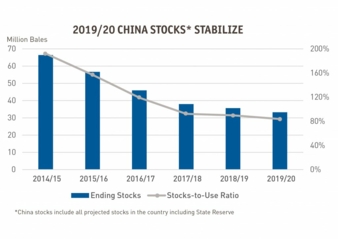22/11/2019 – State reserve stocks forecast at 8-year low — auf Deutsch lesen
USDA forecast on cotton stocks in China
Following annual auctions of the world’s largest cotton reserves, USDA now estimates that China’s State Reserve has reached the government’s preferred level.
State Reserve sales in 2019 (conducted from May to September) exceeded 980,000 tonnes, a level equal to the State Reserve’s announced target. Just under 1.96 million tonnes are estimated to remain (as of Oct. 1 2019); this level is consistent with government’s objectives and is down from more than 13 million tonnes in March 2014.
USDA predicts a strategy of rotation going forward and minimal net changes in stock levels, with the State Reserve auctioning old-crop and replacing with both new-crop domestic cotton and imports for the first time in years. The State Reserve’s demand for foreign supplies is expected up in 2019/20.
The demand was overstated
Despite greater import demand from the State Reserve in 2019/20, China’s total imports are lowered to 2.1 million bales from 2.2 million this month and below the previous year. High levels of cotton in consignment, burgeoning industrial and commercial stocks,³ and stagnant consumption growth have pressured 2019/20 imports lower. China import data includes cotton that hasn’t cleared customs (or is still in consignment), which overstated the fundamental economic demand for foreign cotton in 2018/19: over a fifth of 2018/19 imports are estimated to have remained “in consignment.”
Although 2019/20 imports are slightly lower than the previous year, the total quantity forecast to clear customs and enter the free market is expected to grow. Cotton in consignment for 2019/20 is forecast to halve from the previous year with reduced incentives for storage.
Constant level of consignment
Cotton stored in bonded warehouses was estimated to have more than doubled to over 435,000 tonnes at the end of 2018/19 from the previous year. Private enterprises’ incentive to incur costs of storing cotton in consignment is mostly driven by China’s import policies and allocation of import quota when issued. Due to restrictive import policies pertaining to quota licenses for commercial and industrial enterprises, importers prefer to store cotton close to the port of entry. This pertains to uncertainty surrounding the timing and availability of quota for merchants.
This robust level of consignment is likely due to two factors: the lack of demand for Sliding-Scale Quota (SSQ) issued in late 2018 and unrealized expectations for resolution of the trade disputes between China and the United States.4 A large majority of cotton in bonded warehouses is expected to be of U.S. origin. Regarding the poor performance of the SSQ, foreign cotton wasn’t economically viable when subject to the quota’s price mechanism policy. A significant quantity of quota issued by the government was left unshipped, as importers sought to import outside the SSQ and store in consignment.
China remains world’s largest importer
China is still expected to be the world’s largest importer in 2019/20, exceeding the second-largest (Vietnam) by nearly 440,000 tonnes. This is expected to stabilize domestic supplies, even as total stocks are expected to be the lowest since the country’s formal price support program was initiated more than eight years ago.?
Source: USDA/FAS, Cotton: World Markets and Trade, October 2019




